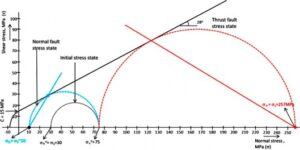Solution Exercise 7
a) The Mohr circles drawn below are related to the formation of normal faults (blue) and thrust faults (red). The vertical stress is the weight of the rock column and is given in Exercise 14 as 75 MPa at the depth of 3,000 m.
For the normal fault, the vertical stress σv corresponds to σ1 (the maximum principal stress). When drawing the circle to find the stress state under which normal faults will form, we hold σv constant at 75 MPa and draw a circle to the left of the maximum principal stress, experimenting with its radius until it just intersects the failure envelope, then complete the blue circle in the image below down to the x-axis to determine the value of the horizontal stress (σ3) and in this case σ3 = 10 MPa.
In the case of a thrust fault, the vertical stress σ3 (is the minimum principal stress) so we hold σv constant at 75 MPa and draw a circle to the right of the minimum principal stress, experimenting with its radius until it just intersects the failure envelope so that thrust faults will be formed, then complete the red circle in the image below down to the x-axis to find the value of σH = σ1, in this case 257 MPa.

b) The dip of each fault is found either by measuring the angle of the blue (normal fault) and red (thrust faults) lines with the horizontal, or by the geometric relationships with φ. So, the dip of the normal fault is 45 + φ/2 and that of the thrust fault is 45 – φ/2, values that are 59o and 31o, respectively.

c) The graph in Exercise 14c shows that, close to the surface, the in-situ average horizontal stress can be as large as 3.5 times the vertical stress. This situation extends from the ground surface down to depths of around 500 to 600 m, the depth range in which most aquifers are located. A consequence of this fact is that we can expect that the structures related to the compressive tectonic regime, either faults (dips around 30o or less) or joints (horizontal), will occur more frequently at shallower depths. Consequently, subhorizontal preferential pathways are expected to be more common at shallower depths.
